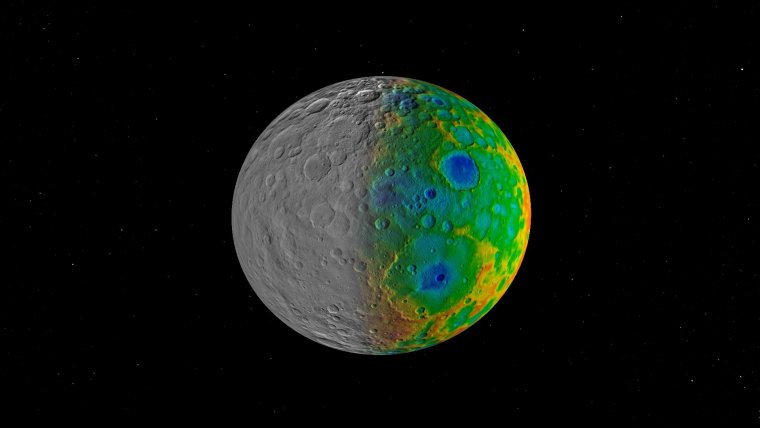| News / Science News |
The Case of the Missing Ceres Craters
NASA | AUGUST 5, 2016
Ceres is covered in countless small, young craters, but none are larger than 175 miles (280 kilometers) in diameter. To scientists, this is a huge mystery, given that the dwarf planet must have been hit by numerous large asteroids during its 4.5 billion-year lifetime. Where did all the large craters go?

Scientists with NASA's Dawn mission were surprised to find that Ceres has no clear signs of truly giant impact basins. This image shows both visible (left) and topographic (right) mapping data from Dawn. ![]()
The scientists at the Southwest Research Institute in Boulder, Colorado, modeled collisions of other bodies with Ceres since the dwarf planet formed, and predicted the number of large craters that should have been present on its surface.
These models predicted Ceres should have up to 10 to 15 craters larger than 250 miles (400 kilometers) in diameter, and at least 40 craters larger than 60 miles (100 kilometers) wide. However, Dawn has shown that Ceres has only 16 craters larger than 60 miles, and none larger than 175 miles (280 kilometers) across.
One idea about Ceres' origins holds that it formed farther out in the solar system, perhaps in the vicinity of Neptune, but migrated in to its present location. However, scientists determined that even if Ceres migrated into the main asteroid belt relatively late in solar system history, it should still have a significant number of large craters.
One reason for the lack of large craters could be related the interior structure of Ceres. There is evidence from Dawn that the upper layers of Ceres contain ice.
Because ice is less dense than rock, the topography could "relax," or smooth out, more quickly if ice or another lower-density material, such as salt, dominates the subsurface composition. Recent analysis of the center of Ceres' Occator Crater suggests that the salts found there could be remnants of a frozen ocean under the surface, and that liquid water could have been present in Ceres' interior.
Past hydrothermal activity, which may have influenced the salts rising to the surface at Occator, could also have something to do with the erasure of craters. If Ceres had widespread cryovolcanic activity in the past -- the eruption of volatiles such as water -- these cryogenic materials also could have flowed across the surface, possibly burying pre-existing large craters. Smaller impacts would have then created new craters on the resurfaced area.
YOU MAY ALSO LIKE



